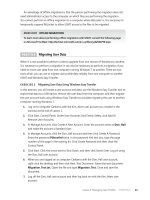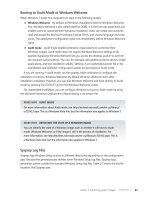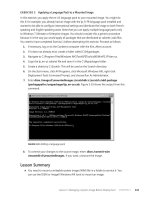Configuring Windows 7 (Training Kit) - Part 9 ppsx
Bạn đang xem bản rút gọn của tài liệu. Xem và tải ngay bản đầy đủ của tài liệu tại đây (259.11 KB, 10 trang )
CHAPTER 2 53
CHAPTER 2
Configuring System Images
A
s a network professional in an enterprise environment, you have probably configured
a reference computer, created an image, and used a distribution server to apply that
image to your client computers. You should be familiar with the Sysprep tool and how you
can remove hardware-specific information from an image. This chapter looks at recent
developments and enhancements to the various tools you use in configuring system images
(disk image files that include an operating system) and in particular the use of file-based
Windows Image (WIM) images and the ImageX tool.
In previous Microsoft operating systems, the use of virtual hard disks (VHDs) containing
system images was limited to virtualization and the facility was used with Hyper-V, Microsoft
Virtual Server, and Microsoft Virtual PC software when implementing virtual machines. In
Windows 7, this has been extended and you can create and use VHDs on hardware PCs that
are not virtual machines. In Windows 7 Enterprise and Ultimate editions, you can boot from
VHD, back up an entire system disk to VHD, and install a system image to VHD. This new
operating system feature enables you to recover quickly from a catastrophic system disk
failure and provides failover protection without needing to implement disk array systems.
This chapter looks at how you capture a system image and prepare it for distribution
to other computers. It also looks at how to configure a VHD to hold a system image and
how to enable a computer running Windows 7 Enterprise or Ultimate to boot from a VHD
containing a system image. The chapter covers the various tools and methods you use to
prepare system images for capture and to manage VHD files.
eXaM tIP
The use of native VHDs on non-virtual computers is a new feature in Windows 7 and is
likely to be tested in the 70-680 examination.
Exam objectives in this chapter:
n
Capture a system image.
n
Configure a VHD.
Lessons in this chapter:
n
Lesson 1: Capturing System Images 56
n
Lesson 2: Managing Virtual Hard Disk Files 89
54 CHAPTER 2 Configuring System Images
Before You Begin
To complete the exercises in the practices in this chapter, you need to have done the
following:
n
Installed Windows 7 on a stand-alone client PC as described in Chapter 1, “Install, Migrate,
or Upgrade to Windows 7.” You need Internet access to complete the exercises.
n
Implemented a second hard disk on this computer to host the VHD you create (this is
an option). You can use an internal disk if one is available, or an external hard disk such
as a USB device. You should have at least 20 GB free space on this hard disk. This is
not essential because you can create a VHD on the C: drive, but it makes your practice
exercises more realistic.
n
You need a USB flash drive (UFD) with 4 GB free memory.
real World
Ian McLean
S
etting up large numbers of computers has become much easier than it was 10 or
even 5 years ago.
I recall going from computer to computer, booting each with a floppy disk that
implemented a subset of MS-DOS that permitted network access and file transfer
(and very little else). Installation files and answer files were then downloaded to
each client computer (often from a single and creakingly slow CD-ROM) and the
operating system was installed. In those days, “hands-free” installation was a bit
of a joke. I recall going around to several hundred computers in the middle of the
night agreeing to licensing terms and conditions.
Installing from captured images posed other difficulties. You typically needed to
capture an image for each computer because of security ID (SID) considerations.
This was OK for teaching networks where you could have images for each course,
but it’s not the way to install a few hundred new computers. Sysprep was one of the
more welcome utilities when it was first introduced. Also, if you captured an image
with time-critical information (for example passwords) and applied it at a later date
you could hit trouble. I recall installing a computer as the domain controller for
a Microsoft Official Course from an image and finding 1,000 passwords had expired.
Also, if you imaged a computer and installed that image later, the security updates
that had been issued in the meantime were not applied, leaving the computer
vulnerable.
Before You Begin CHAPTER 2 55
Now client computers can be installed from image files on a distribution server
(much faster than downloading and running installation files). Images can be
generalized with SIDs and computer names removed. You can add security updates,
language packs, and applications to an image before you distribute it, and keep
images up to date.
Administrators don’t have easy lives. Nevertheless, I think it’s a bit easier now than it
used to be. Learn about the best ways to install large numbers of client computers.
It will make one aspect of your job considerably less arduous. It won’t do you any
harm in your examinations, either!
56 CHAPTER 2 Configuring System Images
Lesson 1: Capturing System Images
This lesson discusses how you prepare a system image for automated or manual capture and
the use of Windows Image (WIM) files. It discusses the Windows Automated Installation Kit
(Windows AIK), the Windows Preinstallation Environment (Windows PE), and the Sysprep
command-line tool.
The lesson briefly discusses the Microsoft Deployment Toolkit (MDT) 2010 and the
Deployment Image Servicing and Management (DISM) tool. However, Chapter 3, “Deploying
System Images,” describes in detail how you use DISM to amend system images and how you
load and install MDT and use it to deploy a system image.
After this lesson, you will be able to:
n
Download and use the Windows AIK. In particular, use the ImageX and Oscdimg
tools to create system images and Windows System Image Manager (Windows
SIM) to create an answer file that enables hands-free installation of a WIM image.
n
Create a Windows PE boot disk, boot to Windows PE, and image a Windows 7
installation.
n
Use the Sysprep utility to prepare a reference computer for imaging and
understand the Windows Setup configuration passes.
n
Understand the functions of the MDT tool and know that you can use
Deployment Workbench to access MDT documentation and to access a checklist
of tasks you must complete before deploying an operating system. Chapter 3
describes this tool in detail.
Estimated lesson time: 50 minutes
Installing and Using the Windows Automated
Installation Toolkit
The Windows Automated Installation Kit (Windows AIK) is a collection of tools and
documentation designed to help you deploy Microsoft Windows operating system images
to target computers or to a VHD. You can use the Windows AIK to automate Windows 7
installations, capture Windows system images with ImageX, configure and modify images using
DISM, create Windows PE images, and migrate user profiles and data with the User State Migration
Tool (USMT).
The Windows AIK consists of a number of tools that enable you to configure various
deployment options. Depending upon your requirements, you will use some or all of the
resources available in the Windows AIK.
To install the Windows AIK, you first download the ISO image, burn it to a DVD-ROM, and
then install from the DVD-ROM. At the time of this writing, you can download the Windows
Lesson 1: Capturing System Images CHAPTER 2 57
AIK International Organization for Standardization (ISO) image by accessing
and clicking the appropriate link.
Installing the Windows AIK from a DVD-ROM
You create an installation DVD-ROM by burning the downloaded ISO image to DVD-ROM.
Right-click the ISO image file and click Burn Disk Image. To install Windows AIK from
DVD-ROM, perform the following steps:
1. Insert the DVD-ROM. On the Welcome screen, click Windows AIK Setup.
2. On the Setup Wizard Welcome page, click Next.
3. Select the I Agree check box to accept the license terms. Click Next.
4. Click Next to accept the defaults on the Select Installation Folder page (unless you
want to change the installation folder).
5. Click Next to start installation. The installation can take some time.
6. Click Close to exit.
When the Windows AIK is installed, you can access the Windows AIK from the All Programs
menu. This gives you access to the Windows AIK documentation; the Deployment Tools
command prompt, which offers command-line utilities that implement ImageX; DISM; the
Oscdimg tool (for creating ISO images); and Windows SIM.
Quick Check
n
Which Windows AIK tool do you use to create an answer file that enables
hands-free installation of a WIM image?
Quick Check Answer
n
Windows SIM
Windows AIK Tools
Table 2-1 lists the tools included with the Windows AIK.
TABLE 2-1 Tools Included in the Windows AIK
TOOL DESCRIPTION
Windows SIM Opens Windows images, creates answer files, and manages distribution
shares and configuration sets.
ImageX Captures, creates, modifies, and applies Windows images.
DISM Applies updates, drivers, and language packs to a Windows image.
DISM is available in all installations of Windows 7.
58 CHAPTER 2 Configuring System Images
TOOL DESCRIPTION
Windows PE
tools
The Windows AIK includes several tools used to build and configure
Windows PE environments.
USMT Used to migrate user data from a previous version of Windows to
Windows 7. USMT is installed as part of the Windows AIK in the
%PROGRAMFILES%\Windows AIK\Tools\USMT directory.
Oscdimg Creates ISO images.
More Info USMT
For more information about USMT, see the User State Migration Tool User’s Guide. When
you install Windows AIK and USMT, you can find this guide at %PROGRAMFILES%\Windows
AIK\Docs\Usmt.chmz.
Using the Windows Preinstallation Environment
The Windows Preinstallation Environment (WinPE version 3.0—commonly known as Windows
PE) is a lightweight version of Windows 7 that is primarily used for the deployment of client
computers. It is intended as a 32-bit or 64-bit replacement for MS-DOS during the installation
phase of Windows 7 and can be booted via the Preboot Execution Environment (PXE),
DVD-ROM, UFD, VHD, or hard disk. Windows PE is available free via the Windows AIK.
Originally, Windows PE was used as a preinstallation platform for deploying Windows
operating systems. It has developed into a platform that lets you deploy workstations and
servers in the enterprise environment and as a recovery platform to run 32-bit or 64-bit
recovery tools such as the Windows Recovery Environment (Windows RE).
Typically you use the copype.cmd script in the C:\Program Files\Windows AIK\Tools\PETools
subdirectory to create a local Windows PE build directory. You then use the Oscdimg Windows
AIK tool in the same subdirectory to create an ISO image of Windows PE 3.0. You use this image
to create a bootable DVD-ROM. You can then boot from the DVD-ROM into the preinstallation
environment and use the ImageX tool to capture a WIM image. You do this in the practice
exercises at the end of this lesson.
Creating a Reference Image
Later in this chapter, you will see how to use the Windows AIK ImageX tool and the Windows
PE environment to prepare a WIM image of a computer running Windows 7 Enterprise or
Ultimate and place that image on a bootable VHD on the same computer so you can boot
the image from the VHD. This gives you failover protection for that specific computer and
a form of backup. You do this in the practices in this lesson and Lesson 2 of this chapter.
However, in the enterprise environment, you are more likely to be concerned with installing
Windows 7, on a reference computer and generating an image of that reference computer that
can be installed on a large number of client computers on your network. Chapter 3 discusses
Lesson 1: Capturing System Images CHAPTER 2 59
adding the current operating system security updates, basic applications, and language packs
to a captured image.
eXaM tIP
If you want to capture an image of your current computer running Windows 7 and save the
image to a VHD from which you can boot the computer, you need Windows 7 Enterprise or
Ultimate installed on the computer. However, if you have built a reference computer and
want to create a system image of that computer to distribute to a number of destination
computers, you can use any Windows 7 edition to create an image for distribution.
You need to generalize a reference image, removing hardware-specific information
(such as the reference computer’s SID), and generate an installation answer file and scripts to
automate the installation.
Typically, in addition to the reference computer whose image you intend to build and
capture, you require a technician computer that runs the tools you use to generalize and
capture the image, for example the Windows AIK tools. The technician computer does not need
to be running Windows 7—it could, for example, be a Windows Vista or Windows XP client.
The procedure for installing the Windows AIK on the technician computer is described in
the previous section. To configure a reference computer and capture an image suitable for
distribution to your client computers, you perform the following steps:
1. Build an answer file to automate the installation of Windows 7 on the reference
computer (this is an option).
2. Validate and save your settings.
3. Configure a reference installation.
4. Create a bootable Windows PE optical disk or UFD that also contains the ImageX
Windows AIK tool.
5. Capture the installation onto a network share.
6. Deploy the image from a network share.
note USING AN ANSWER FILE
It is not compulsory to create an answer file, although this is the method recommended in
Microsoft documentation. If you choose, you can install the reference computer manually.
Building an Answer File
The first step in creating a custom installation on your reference computer is (optionally)
to build an answer file on your technician computer that you use to configure Windows
settings during installation. You can, for example, configure the default Windows Internet
Explorer settings, networking configuration, and other customizations. The answer file should
contain all the settings required for an unattended installation so you are not prompted with
user interface pages during installation. However, if you choose, you can build a reference
computer using the traditional “click and type” installation method.
60 CHAPTER 2 Configuring System Images
You use the Windows SIM utility in Windows AIK on your technician computer to create
an answer file that includes basic Windows Setup configuration and minimum Windows
Welcome customizations. In this example, the answer file does not import any special drivers,
applications, or packages. You will study more advanced answer files in Chapter 3.
note SAMPLE ANSWER FILE
When you install the Windows AIK on your technician computer, a sample answer file,
Corp_autounattended_sample.xml, is installed at C:\Program Files\Windows AIK\Samples.
To create an answer file, you copy a Windows image (WIM) file to your technician computer
and then use the Windows SIM tool. To create an answer file that will enable you to install
Windows 7 on your reference computer using the WIM file on the installation DVD-ROM,
perform the following procedure:
1. Create a folder on your technician computer called C:\Myimages.
2. Insert the Windows 7 product DVD into your technician computer.
3. Navigate to the \Sources directory on your DVD-ROM drive and copy the Install.wim
file from the Windows product DVD to C:\Myimages.
4. Click Start, All Programs, Microsoft Windows AIK, and then Windows System Image
Manager. This opens Windows SIM.
5. On the Windows SIM File menu, right-click Select A Windows Image Or Catalog File
and choose Select Windows Image, as shown in Figure 2-1.
FIGURE 2-1 Selecting a Windows image
6. In the Select A Windows Image dialog box, navigate to C:\Myimages and then
click Open.
Lesson 1: Capturing System Images CHAPTER 2 61
7. You are prompted to select an image. Choose Install.wim and click Open. Select the
image you want to install (for example, Windows 7 Ultimate) in the Select An Image
dialog box and click OK.
8. If you are prompted to create a catalog file, click Yes. If prompted, click Yes again to
allow the program to run. It can take some time to create a catalog file.
9. On the File menu, choose New Answer File. An empty (untitled) answer file appears in
the Answer File pane, as shown in Figure 2-2.
FIGURE 2-2 Creating an empty answer file
10. In the Windows SIM Windows Image pane, expand the Components node to display
available feature settings.
11. On the expanded list of features, add features to your answer file by right-clicking each
feature and then selecting the appropriate configuration pass. Table 2-2 shows a basic
set of features and their associated configuration passes. Select a configuration pass, as
shown in Figure 2-3.
TABLE 2-2 Specifying Features and Their Associated Configuration Passes
FEATURE
CONFIGURATION
PASS
x86_Microsoft-Windows-Deployment_6-1.<build>_neutral
oobeSystem
x86_Microsoft-Windows-International-Core-WinPE_
6-1.<build>_neutral
windowsPE
x86_Microsoft-Windows-Setup_6-1.<build>_neutral
windowsPE
x86_Microsoft-Windows-Shell-Setup_6-1.<build>_neutral
oobeSystem
62 CHAPTER 2 Configuring System Images
FIGURE 2-3 Selecting a configuration pass
12. Under Settings, select the appropriate setting and, in the right column, enter the
appropriate value. Typical values are shown in Table 2-3 (for example, the table shows
entries for the English-US Locale). Figure 2-4 shows the Windows SIM dialog box
TABLE 2-3 Adding Component Values
CONFIGURATION
PASS FEATURE VALUE
WindowsPE x86_Microsoft-Windows-
International-Core-WinPE_
6-1.<build>_neutral
InputLocale = en-US
SystemLocale = en-US
UILanguage = en-US
UserLocale = en-US
WindowsPE x86_Microsoft-Windows-
Setup_6-1.<build>_neutral
EnableFirewall = true
EnableNetwork = true
LogPath = <path to log files>
Restart = Restart
UseConfigurationSet = true









